Room temperature standards: comfortable indoor conditions for human habitation
In our apartments, the microclimate is formed by several factors and room temperature is its most significant part.Thermal comfort of household members is individual, depending on their gender and age. However, the difference in heat needs between members of the same family is small and amounts to 2-3°C, allowed by SanPiN standards.
We will tell you how to determine the optimal temperature and how excessive cooling or overheating affects people’s well-being. In addition, we will outline the parameters of a comfortable microclimate, and also provide effective ways to maintain normal temperature conditions in the room.
The content of the article:
What determines the optimal temperature of an apartment?
The temperature regimes that provide comfort to households depend on the climatic location of the home. In the southern regions and in the northern areas, as well as in western and eastern latitudes, the normal house temperature will be different.
As for countries, their climate is also different. And since the components of climate, in addition to temperature, are atmospheric pressure along with air humidity, the acceptable thermal range is set by them together.
For example, humidity of the home atmosphere: the high humidity characteristic of hot countries requires higher values for the normal temperature of the home, because heat-intensive, moisture-saturated air actively takes away the heat of human bodies.
Temperature formation
The temperature inside a home changes due to the periodic change of seasons. Summer is always warmer than winter.In a temperate climate zone, the acceptable room temperature in the warm season will be +22...+25°C, in the cold season - +19...+22°C. Considering the duration of exposure, the seasonal temperature difference, although apparently small, still matters.
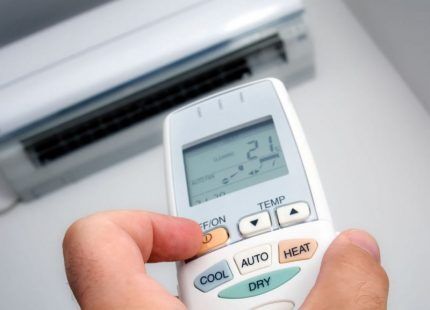
Finally, a comfortable temperature for a person in various rooms of an apartment is associated with his gender and age characteristics.
Let us note right away that personal preferences for one or another temperature regime do not mean health benefits. Excessive overheating, for example, refusal of air conditioning in hot weather, or hypothermia of a room due to a window open in cold weather, certainly harms the human body.
The maintained optimal air temperature in the room must correspond to the temperature needs of household members of different genders and ages. For example, for women a comfortable home atmosphere will be 2-3°C is higher than for men – women are more thermophilic.
Young children need a room with a stable temperature in the range of +20°C...+23°C. Temperature changes are especially difficult to tolerate for an infant, whose body is not yet capable of full (adult) thermoregulation.
For the room where the baby is located, it is extremely important to maintain a stable temperature level of +23°C...+24°C all year round, since a small child overheats and freezes much faster than adults.
Dangers of cold rooms
In medical terminology, hypothermia is called hypothermia - a condition that causes profound harm to the human body, contributing to the development of diseases of the nervous system and respiratory diseases.
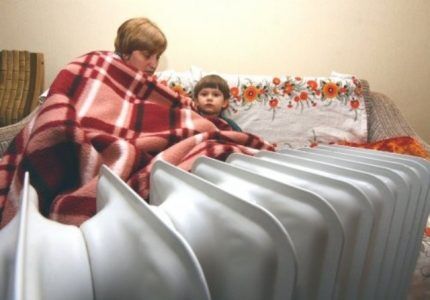
Once in a cold atmosphere, our body strives to block hypothermia by using energy resources and sharply increasing heat transfer. This works when exposed to the cold for short periods of time.
However, with prolonged exposure to low temperatures, the body’s resources to compensate for heat loss are insufficient and the body cools below +36°C.
A characteristic sign of hypothermia is shivering, stimulated by the body in response to cold - excessive muscle activity produces heat. Hands and feet become cold because the blood vessels in them contract to reduce blood flow and reduce overall body cooling.
A decrease in body temperature below +35°C will cause a slowdown in the heart rate, breathing and weaken mental activity.
Hypothermia is especially dangerous for young children, whose bodies are physically smaller than adults and are not able to quickly produce heat. A child's body suffers from cold much more deeply than an adult.
Risks of excessively warm rooms
A hot room atmosphere creates ideal conditions for the development of pathogens that cause infectious diseases, primarily skin and intestinal diseases.
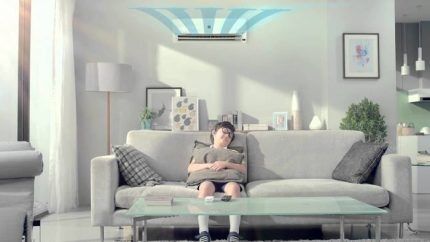
Hyperthermia has a detrimental effect on the human body, especially on the heart. In the hot microclimate of the room, a person sweats, which is why he loses a significant amount of moisture.
The blood thickens and becomes “heavy,” requiring the heart to work harder to pump it into the blood vessels. In case of cardiovascular diseases, such loads will be extremely heavy.
Dehydration, caused by the body's desire to balance external and internal temperatures, worsens the water and electrolyte balance of the human body and weakens the nervous system.
An overly warm bedroom atmosphere contributes to the development of insomnia by interfering with normal body thermoregulation. In a moderately cool microclimate, the body quickly moves into the deep phase of sleep, redistributing internal heat from the center of the body to the extremities.
Apartment temperature standards
State standards for seasonal temperature are established in GOST 30494 and SanPiN 2.1.2.2645-10. The optimal temperature conditions for the living rooms of an apartment according to the above-mentioned state standards is the range of +20...+22°C in winter and +22...+25°C in summer.

For technical rooms, in any annual season, temperatures are defined in the range of +19...+21°C for the bathroom and kitchen, +24°...+26°C for the bathroom and +16...+18°C for the pantry.
Understanding the difficulty of maintaining the temperature state of the microclimate within 2-3°Based on optimal conditions, the developers of these standards in their text part outlined the permissible ranges of room temperatures, namely:
- living rooms — +18°С...+24°С in winter, +20°С...+28°С in summer;
- kitchen and bathroom — +18°С…+24°С;
- combined bathroom — +18°…+26°С;
- pantry — +12°С…+22°С.
Obviously, the permissible upper temperature range for non-residential premises, for example, +24°C for a bathroom and kitchen, according to state standards is focused on the warm annual period, and the lower, for example, +12°C for a pantry, is aimed at the cold period.
Comfortable microclimate parameters
Gost standards are largely intended for designers, housing and communal services and judicial procedural departments, since they establish mandatory temperatures for residential premises.
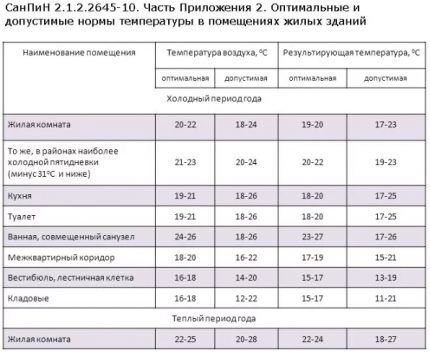
However, the full formation of a home microclimate requires attention to the recommendations of experienced doctors and psychologists, and to the individual preferences of household members.
Bedroom. The human body needs sleep not only because of fatigue during the period of wakefulness - to produce the hormone melatonin, which controls the biorhythms of our bodies.
The lack of acceptable conditions for sleep and, accordingly, the hormonal activation of melatonin results in insomnia and a “broken” state - general weakness and headache, slowing down the mental functions of the brain.
For proper rest of adult household members, the temperature in their bedrooms should be maintained in the range of +17°С…+18°С, i.e. The “sleeping” microclimate should be cooler than other living spaces. It is more difficult to fall asleep in a warmer or cooler atmosphere.
Children's room. Its optimal temperature is determined by the age of the child. For a baby, the best is +23°C...+24°C, since the baby’s body is not capable of “adult” thermoregulation. For children over 3 years old, the room temperature will be +21°С…+22°С.
Kitchen room. The operation of household equipment from the usual kitchen set - stove, oven, electric kettle, microwave, hood, etc. - is always accompanied by heat generation. Accordingly, when preparing food, the kitchen atmosphere becomes warmer than in other rooms.
Given the traditionally small size of the kitchen, the heat radiation from kitchen appliances warms it up quite quickly. Therefore, it is enough to maintain the temperature of this room in the range of 18-19°C.
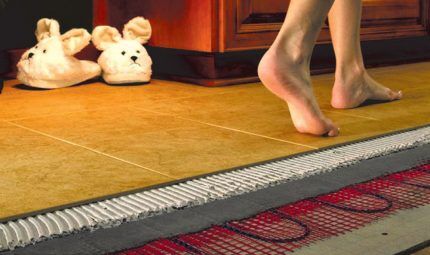
Bathroom. Bathing procedures are accompanied by intense saturation of the bathroom atmosphere with moisture, which is why the microclimate of a room with a temperature outside the range of 24-26°C will be uncomfortable.
For other rooms and corridors, the comfortable temperature will be 18-22°C. Temperature differences between apartment rooms should not be more than 2-3 degrees,
In winter, less heat is required, in summer - more. Otherwise, the temperature imbalance between the external environment (street) and living quarters will be stressful for the body.
A sharp change in the temperature of the surrounding space when going outside from the microclimate of the apartment may be followed by hypothermia or overheating of the body, which, as discussed above, is equally bad.
The optimal difference in atmospheric temperatures between the house and the street during the transition between them is 4-5°C. Therefore, you should not overheat the apartment in winter or overcool in summer.
How to ensure temperature conditions?
The tasks of maintaining the microclimate in the optimal temperature range are divided into two - cooling the atmosphere of rooms in the warm months and heating during the cold season.
It will cope with the first task quite well air conditioning equipment, placed independently in the bedrooms, living room and kitchen. Temperature sensors of single-block and double-block air conditioners (split system) will maintain the set temperature, strictly following user settings.
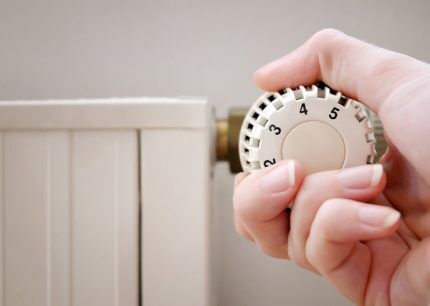
It is more rational to use inverter climate control equipment, capable of maintaining the temperature of the room microclimate gently, without sudden emissions of cold air currents.
Until mid-September, split systems are able to operate for heat even in a temperate climate zone, but as the temperature difference “apartment-street” increases, it will be impossible to use split systems for heating.
The task of maintaining a comfortable atmosphere in the house will shift to heating equipment - central heating radiators and "warm floor" systems.
It is not difficult to control the temperature conditions of the “warm floor” heating complex.Liquid systems are equipped with a thermostatic valve or an automatic pumping and mixing group, which are equally capable of controlling the temperature of the coolant circulating through the circuit built into the floor.
In infrared and electric floors temperature control is carried out by digital, programmable or electromechanical thermostats. By constantly checking temperature changes against preset thresholds, they turn the system off or on.
Classic apartment heating systems, based on the circulation of hot water through pipes into radiators, also allow temperature control.
It will be necessary to equip the pipe at the coolant inlet into the radiator with automatic temperature controller (thermostat) that controls the intensity of hot water supply according to a given parameter.
Note that it is easier to equip a circulation-radiator heating system with battery thermostats when it is two-pipe version. For a single-pipe circuit, it is necessary to supplement the pipe circuit with a bypass, which creates an outlet channel for the coolant in front of the radiator.
Conclusions and useful video on the topic
On the importance of a warm room atmosphere for newborns:
Shut-off equipment for temperature control of heating radiators:
Proper apartment climate control using split systems:
The need to establish and maintain optimal temperature conditions in living rooms is important, since the microclimate of the apartment significantly affects the health of household members.
Temperature imbalance aggravates chronic diseases and contributes to the acquisition of new ones, and normalizing the atmosphere in temperature, on the contrary, will strengthen the body.
Share with readers your personal observations regarding the parameters of a comfortable temperature at home. Tell us about ways to normalize temperature. Please leave comments on the article, ask questions and participate in discussions. The contact form is located below.




It is very cold in our apartment in autumn and winter. Even when the temperature outside is above zero, for example, from +1 to +5, then it’s warm when the batteries are turned on. As soon as the air temperature outside drops to minus, the apartment becomes cold, the air temperature is +16. We have a small child, we have to turn on the heater, but it dries out the air - this is also not good for the child. Therefore, we insulate ourselves with warm clothes.
Hello. Why do you tolerate such negligence from your management company? The temperature standard in apartments is set by GOST R 51617-2000 and SanPin. Any deviations from it must be eliminated by them. Write a complaint to the Criminal Code in cold weather, if they do not respond and do not come with an inspection, conduct an independent examination of the temperature regime and feel free to file a complaint against the Criminal Code in court, the housing inspectorate or the prosecutor's office. As a rule, people win such cases, tariffs are recalculated, and the Criminal Code pays the fine.
Unfortunately, these standards are rarely observed by management companies. While the children were small, they were constantly sick. It's cold at home in autumn. Even when heating is on, the radiators are barely warm. And in the spring, the temperature often dropped closer to zero. Fortunately, there has been a positive trend lately. The heating season is being extended, but everything costs a pretty penny.
We had gas connected to our house, but, as we have seen, it is very difficult to control the temperature without sensors. We decided to switch to wood stoves. Even in a large house, this is a convenient option: the stove does not release heat immediately, but evenly throughout the day. Of course, taking care of the stove is a troublesome task: you need to drag firewood into the house, constantly clean around the stove, and clean it of soot, but the benefits to the family budget are undeniable. The husband drags logs with a trailer on his car, and he cuts and chops himself. Almost no costs, and the house is always comfortable.
Hello. Well done! I would like to give you some tips on soot:
1. The most polluted chimneys with soot are coniferous trees, birch bark and pellets. The best wood for the stove is considered to be apple, oak, hornbeam, poplar, pear, and so on.
2. Maintain combustion temperature from 120 to 320 degrees; heating at a lower temperature increases deposits. By the way, during kindling, it is worth preheating the combustion chamber with wood chips and finely chopped firewood and closing the stove damper in time.
3. It is not recommended to use damp firewood, as it contributes to the formation of deposits.
4. Do not burn waste in the oven, especially plastic, ops, or materials with a paint coating.
5. During intense combustion, throw potato peelings into the firebox; they will soften the soot, thanks to the starch, and it will be much easier to clean the oven. This is an old method. You can also throw a handful of regular table salt onto the firewood in the nozzle before kindling.
6.Aspen and birch firewood (not bark!) should be used in the final stage of lining, as they help peel off the soot, and since at this time the oven temperature is at its maximum, it will burn and not just fall into the nozzle.
Good luck and thanks for sharing your experience.
People, there is no need to freeze and endure. If the temperature in the apartment is lower than it should be, then call the management company, they will send a person who will have to measure the temperature and fix the problem. If you can’t solve it right away, then management companies are obliged to change your heating tariff. Pay must be reduced by 0.15% for each hour the standards are not met. If the Criminal Code does not want to do anything, then write to the consumer protection society and the prosecutor's office. The main thing is to make all complaints in writing.
Please explain why a temperature of 36.6°C is not considered the norm for residential premises, since it is the most natural temperature for the body? Isn't this logical?
Are you really serious about a temperature of 36.6??? Yes, at such a temperature you can regularly just die... here it’s 27.9, despite the fact that it’s +10+15 outside... and they heat it like that on purpose, one gets the impression... we should complain about this too.
I would like to know how to deal with the HOA if the air temperature in the apartment is 18-19 degrees, and in the radiator the water temperature hardly reaches 40 degrees. Living all winter is not physiologically comfortable. But according to the standards approved by government agencies, this is permissible, and nothing more can be achieved?